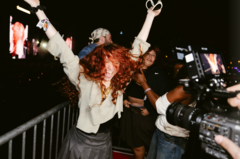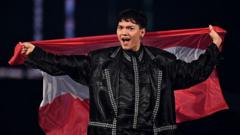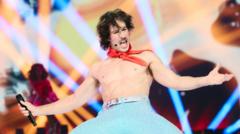Thirty-five seconds. That’s the tight window Eurovision’s backstage crew has to execute flawless set changes during the high-profile music contest. In the midst of captivating performances and colorful visuals, a diligent team scurries behind the scenes, orchestrating a swift and silent transformation from one act to the next, ensuring everything is set perfectly.
Richard van Rouwendaal, the Dutch stage manager, likens their coordination to a "Formula 1 tire change," emphasizing efficiency. Each crew member is assigned a singular task, making their movements almost choreographed. “You always walk on the same line,” he says. “If you go off course, you will hit somebody,” likening the process to ice skating, a delicate dance in a confined space.
The groundwork for these rapid transitions begins weeks in advance, with meticulous rehearsals by stagehands who are often joined by stand-ins from local performing arts schools. They shave precious seconds off the transitions, practicing tirelessly to ensure precision. Van Rouwendaal oversees a mix of Dutch team members and local talent in Basel for this year’s event, selecting the best individuals for distinct roles.
The behind-the-scenes operation involves not just stagehands but also technicians managing lights and pyrotechnics, alongside a dedicated cleaning crew. Van Rouwendaal stresses the importance of a spotless stage for performers, especially when high-definition cameras are capturing every moment.
Staging gone wrong is a constant worry. A sudden change—like an artist deciding to switch shoes—could affect the microphone height set for them. Van Rouwendaal recalls challenges from previous contests, such as dealing with steep ramps for weighty set pieces. However, this year's setup has made significant improvements with extra storage space and efficient organization.
Props play a vital role in Eurovision performances, from disco balls to spectacular set pieces like Spain's giant staircase. Damaris Reist, deputy head of production, describes the approach to managing props as a circular system, where every gage is meticulously accounted for, ensuring that everything aligns perfectly as it moves on and off the stage.
During the live show, various tricks are executed to maintain a seamless flow. Van Rouwendaal recounts the moment during a past performance when he discreetly slipped an electric guitar onto the stage, making it emerge as if by magic, highlighting the precision timing shared between on-stage performers and the crew.
Containment of faults during a live broadcast is essential; quick thinking by the crew can prevent the audience from noticing mishaps. Strategies include showing extended shots of the audience when things don’t go as planned or switching to pre-recorded footage if a larger issue arises.
As the team works long hours leading up to the show, organisers have initiated measures to protect their wellbeing, like extended breaks and a designated “disconnected zone” free from cameras. Van Rouwendaal recalls days turning into 20-hour shifts, joking about a past bunker equipped with comforts to help the crew manage stress. Though he may lack such luxuries, camaraderie remains key, with moments of shared laughter and celebrations punctuating rigorous schedules.
Ultimately, if everything goes well during Eurovision’s live event, the audience won’t even realize that this invisible crew exists, highlighting both their crucial role and expert execution during the famed event.





















